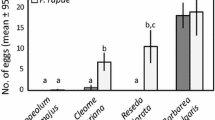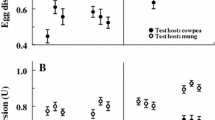Abstract
Animals often express behavioral preferences for different types of food or other resources, and these preferences can evolve or shift following association with novel food types. Shifts in preference can involve at least two phenomena: a change in rank preference or a change in specificity. The former corresponds to a change in the order in which hosts are preferred, while a shift in specificity can be an increase in the tendency to utilize multiple hosts. These possibilities have been examined in relatively few systems that include extensive population-level replication. The Melissa blue butterfly, Lycaeides melissa, has colonized exotic alfalfa, Medicago sativa, throughout western North America. We assayed the host preferences of 229 females from ten populations associated with novel and native hosts. In four out of five native-associated populations, a native host was preferred over the exotic host, while preference for a native host characterized only two out of five of the alfalfa-associated populations. Across all individuals from alfalfa-associated populations, there appears to have been a decrease in specificity: females from these populations lay fewer eggs on the native host and more eggs on the exotic relative to females from native-host populations. However, females from alfalfa-associated populations did not lay more eggs on a third plant species, which suggests that preferences for specific hosts in this system can potentially be gained and lost independently. Geographic variation in oviposition preference in L. melissa highlights the value of surveying a large number of populations when studying the evolution of a complex behavioral trait.






Similar content being viewed by others

References
Barron AB (2001) The life and death of Hopkins’ host-selection principle. J Insect Behav 14:725–737
Burnham KP, Anderson DR (2002) Model selection and multimodel inference: a practical information-theoretic approach. Springer, Berlin
Carroll SP, Dingle H (1996) The biology of post-invasion events. Biol Conserv 78:207–214
Conover WJ (1999) Practical nonparametric statistics. Wiley, New York
Courtney SP, Chen GK, Gardner A (1989) A general model for individual host selection. Oikos: 55:55–65
Davis JM (2008) Patterns of variation in the influence of natal experience on habitat choice. Q Rev Biol 83:363–380
Egan SP, Funk DJ (2006) Individual advantages to ecological specialization: insights on cognitive constraints from three conspecific taxa. Proc R Soc B 273:843–848
Fordyce JA (2010) Host shifts and evolutionary radiations of butterflies. Proc R Soc B 277:3735–3743
Fordyce JA, Nice CC (2003) Variation in butterfly egg adhesion: adaptation to local host plant senescence characteristics? Ecol Lett 6:23–27
Fordyce JA, Gompert Z, Forister ML, Nice CC (2011) A hierarchical approach to ecological count data: a flexible tool for ecologists. PLoS ONE 6:e26785
Forister ML (2008) Experimental design and the outcome of preference-performance assays, with examples from Mitoura butterflies (lycaenidae). J Lepid Soc 62:99–105
Forister ML, Ehmer AG, Futuyma DJ (2007) The genetic architecture of a niche: variation and covariation in host use traits in the Colorado potato beetle. J Evol Biol 20:985–996
Forister ML, Nice CC, Fordyce JA, Gompert Z (2009) Host range evolution is not driven by the optimization of larval performance: the case of Lycaeides melissa (Lepidoptera: Lycaenidae) and the colonization of alfalfa. Oecologia 160:551–561
Forister ML, Gompert A, Nice CC, Forister ML, Fordyce JA (2011) Ant association facilitates the evolution of diet breadth in a lycaenid butterfly. Proc R Soc B 278:1539–1547
Gompert Z, Fordyce JA, Forister ML, Shapiro AM, Nice CC (2006) Homoploid hybrid speciation in an extreme habitat. Science 314:1923–1925
Gompert Z, Lucas LK, Fordyce JA, Forister ML, Nice CC (2010) Secondary contact between Lycaeides idas and L. melissa in the Rocky Mountains: extensive admixture and a patchy hybrid zone. Mol Ecol 19:3171–3192
Gripenberg S, Mayhew PJ, Parnell M, Roslin T (2010) A meta-analysis of preference-performance relationships in phytophagous insects. Ecol Lett 13:383–393
Hawthorne DJ, Via S (2001) Genetic linkage of ecological specialization and reproductive isolation in pea aphids. Nature 412:904–907
Jaenike J (1990) Host specialization in phytophagous insects. Annu Rev Ecol Syst 21:243–273
Jahner JP, Bonilla MM, Badik KJ, Shapiro AM, Forister ML (2011) Use of exotic hosts by Lepidoptera: widespread species colonize more novel hosts. Evolution 65:2719–2724
Janz N (2011) Ehrlich and Raven revisited: mechanisms underlying codiversification of plants and enemies. Annu Rev Ecol Evol Syst 42:71–89
Janz N, Nylin S (2008) The oscillation hypothesis of host-plant range and speciation. In: Tilmon KJ (ed) Specialization, speciation and radiation: the evolutionary biology of herbivorous insects. University of California Press, Berkeley, pp 203–215
Janz N, Soderlind L, Nylin S (2009) No effect of larval experience on adult host preferences in Polygonia c-album (Lepidoptera: Nymphalidae): on the persistence of Hopkins’ host selection principle. Ecol Entomol 34:50–57
Keeler MS, Chew FS (2008) Escaping an evolutionary trap: preference and performance of a native insect on an exotic invasive host. Oecologia 156:559–568
Linn C, Feder JL, Nojima S, Dambroski HR, Berlocher SH, Roelofs W (2003) Fruit odor discrimination and sympatric host race formation in Rhagoletis. Proc Natl Acad Sci USA 100:11490–11493
Lucas LK, Fordyce JA, Nice CC (2008) Patterns of genitalic morphology around suture zones in North American Lycaeides (Lepidoptera : Lycaenidae): Implications for taxonomy and historical biogeography. Ann Entomol Soc Am 101:172–180
McBride CS (2007) Rapid evolution of smell and taste receptor genes during host specialization in Drosophila sechellia. Proc Natl Acad Sci USA 104:4996–5001
Mercader R, Scriber J (2007) Diversification of host use in two polyphagous butterflies: differences in oviposition specificity or host rank hierarchy? Entomol Exp Appl 125:89–101
Mercader RJ, Aardema ML, Scriber JM (2009) Hybridization leads to host-use divergence in a polyphagous butterfly sibling species pair. Oecologia 158:651–662
Michaud R, Lehman WF, Rumbaugh MD (1988) World distribution and historical developments. In: Hanson AA, Barnes DK, Hill RR (eds) Alfalfa and alfalfa improvement, vol 29. American Society of Agronomy, Madison, pp 25–56
Nice CC, Fordyce JA, Shapiro AM, Ffrench-Constant R (2002) Lack of evidence for reproductive isolation among ecologically specialised lycaenid butterflies. Ecol Entomol 27:702–712
Nylin S, Bergstrom A, Janz N (2000) Butterfly host plant choice in the face of possible confusion. J Insect Behav 13:469–482
Scholl CF, Nice CC, Fordyce JA, Gompert Z, Forister ML (2012) Larval performance in the context of ecological diversification and speciation in Lycaeides butterflies. Int J Ecol. doi:10.1155/2012/242154
Singer MC (1982) Quantification of host preference by manipulation of oviposition behavior in the butterfly Euphydryas editha. Oecologia 52:224–229
Singer MC, Vasco D, Parmesan C, Thomas CD, Ng D (1992a) Distinguishing between preference and motivation in food choice: an example from insect oviposition. Anim Behav 44:463–471
Singer MC, Ng D, Vasco D, Thomas CD (1992b) Rapidly evolving associations among oviposition preferences fail to constrain evolution of insect diet. Am Nat 139:9–20
Singer MC, Thomas CD, Parmesan C (1993) Rapid human-induced evolution of insect diet. Nature 366:681–683
Singer MC, Thomas CD, Billington HL, Parmesan C (1994) Correlates of speed of evolution of host preference in a set of twelve populations of the butterfly Euphydryas editha. Ecoscience 1:107–114
Singer MC, Stefanescu C, Pen I (2002) When random sampling does not work: standard design falsely indicates maladaptive host preferences in a butterfly. Ecol Lett 5:1–6
Singer MC, Wee B, Hawkins S, Butcher M (2008) Rapid natural and anthropogenic diet evolution: three examples from checkerspot butterflies. In: Tilmon KJ (ed) Specialization, speciation, and radiation: the evolutionary biology of herbivorous insects. The University of California Press, Berkeley, pp 311–324
Spiegelhalter DJ, Best NG, Carlin BP, Van Der Linde A (2002) Bayesian measures of model complexity and fit. J R Stat Soc Ser B (Stat Method) 64:583–639
Tabashnik BE (1983) Host range evolution: the shift from native legume hosts to alfalfa by the butterfly, Colias philodice eriphyle. Evolution 37:150–162
Thompson JN (1998) The evolution of diet breadth: monophagy and polyphagy in swallowtail butterflies. J Evol Biol 11:563–578
Thompson JN, Pellmyr O (1991) Evolution of oviposition behavior and host preference in Lepidoptera. Annu Rev Entomol 36:65–89
Tosh CR, Krause J, Ruxton GD (2009) Theoretical predictions strongly support decision accuracy as a major driver of ecological specialization. Proc Natl Acad Sci USA 106:5698–5702
Zhang PJ, Liu SS, Wang H, Zalucki MP (2007) The influence of early adult experience and larval food restriction on responses toward nonhost plants in moths. J Chem Ecol 33:1528–1541
Acknowledgments
This work was supported by the National Science Foundation: DEB-1020509 and DEB-1050726 to MLF; IOS-1021873 and DEB-1050355 to CCN; DEB-0614223 and DEB-1050947 to JAF; and DEB-1011173 to ZG. JPJ was supported by the graduate group in Ecology, Evolution and Conservation Biology at the University of Nevada, Reno. Thanks to Mike C. Singer for discussion and comments.
Author information
Authors and Affiliations
Corresponding author
Additional information
Communicated by Konrad Fiedler.
Rights and permissions
About this article
Cite this article
Forister, M.L., Scholl, C.F., Jahner, J.P. et al. Specificity, rank preference, and the colonization of a non-native host plant by the Melissa blue butterfly. Oecologia 172, 177–188 (2013). https://doi.org/10.1007/s00442-012-2476-8
Received:
Accepted:
Published:
Issue Date:
DOI: https://doi.org/10.1007/s00442-012-2476-8



